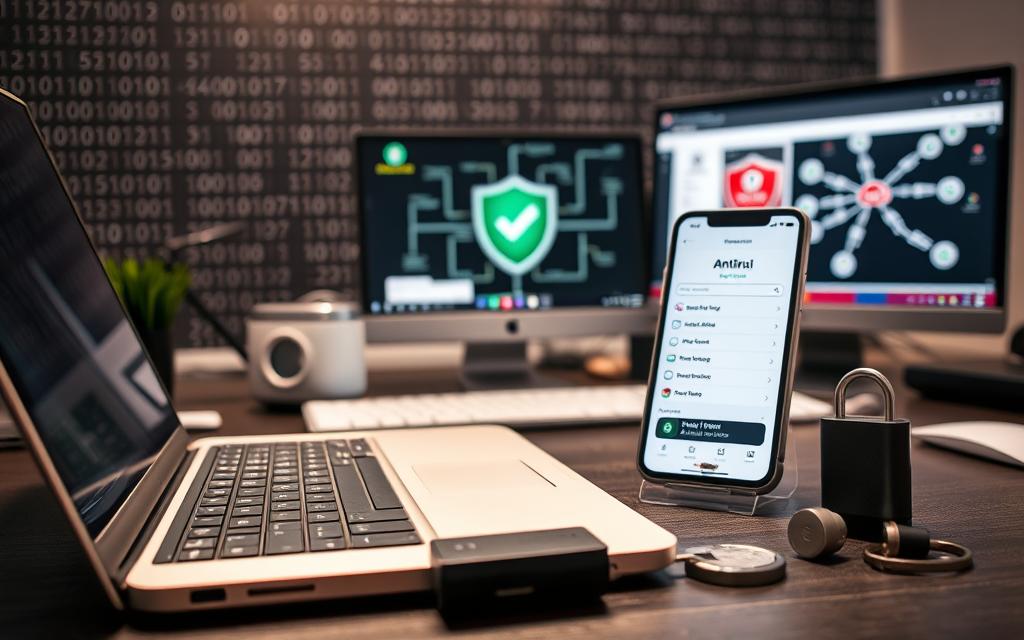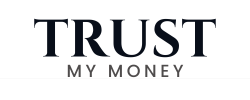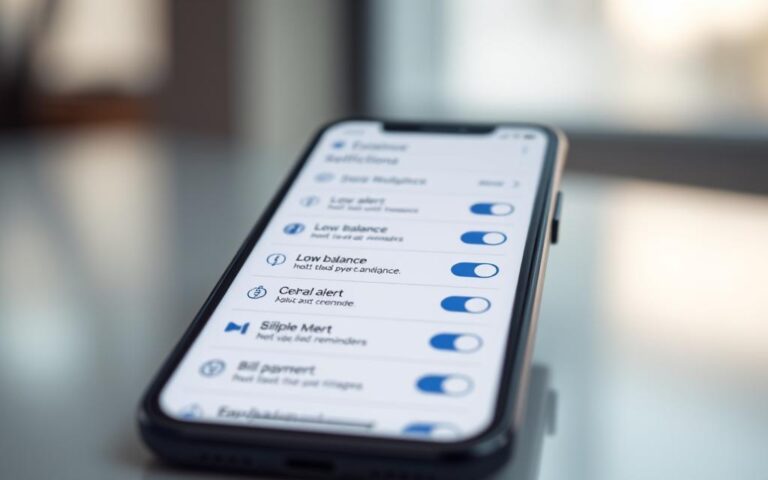Advertisement
About 43% of cyber attacks hit small businesses, making them open to danger. We’re living in a time when keeping our online accounts safe is crucial. But, securing your accounts doesn’t mean you have to break the bank. There’s a bunch of free online security tools out there to up your cybersecurity game without costing a dime.
This guide will show you how to keep your online accounts safe for free. Whether you want to activate two-factor authentication or make up strong passwords, our tips will help. Everyone can have top-notch protection without spending any money.
Introduction: Digital Security Within Everyone’s Reach
Today, the need for strong digital security is critical. Our daily lives are deeply connected with technology, bringing risks like data breaches and identity theft. An eye-opening stat shows nearly 60% of small businesses suffer a cyberattack, proving that these threats are real for everyone.
Though keeping digital data safe may sound tough, it’s possible to do so on a budget. Many free cybersecurity tools available help protect online accounts easily. These tools offer a way for everyone to guard their online presence without spending a lot.
Using free cybersecurity tools not only keeps us safer but also encourages us to be proactive about online safety. Even simple steps can greatly protect our sensitive information in today’s digital world.

Why You Need to Protect Your Accounts
In today’s world, protecting your online accounts is super important. Cyber attacks and identity theft are on the rise. A lot of internet users have faced security issues, showing how vital strong security is.
There are real stories of people losing money and feeling the sting of stolen personal info. Also, companies suffer from bad reputations and even legal trouble after data breaches. These examples show the big risks of cyber threats in our connected world.
Failing to protect your accounts can lead to more than just lost money. Personal info can be used in many wrong ways, like fraud or identity theft, which are hard to fix. Making sure your accounts are safe is key to keeping your data and money secure online.
Effective Free Tools for Online Security
Protecting yourself online doesn’t have to cost money. Many free tools offer strong protection against digital dangers. These free tools help keep you safe without spending anything, and they work well too.
Some key tools include two-factor authentication, password managers, and free antivirus programs.
Popular Free Security Tools to Consider
- Authy: Ideal for two-factor authentication, enhancing login security through unique codes.
- Bitwarden: A strong contender for password management, allowing secure storage and easy access.
- Malwarebytes Free: A dependable option for free antivirus software, protecting against malware and other threats.
Benefits of Using Free Tools
Free security tools offer many benefits. They don’t cost anything, so everyone can use them. They’re easy to use, even for people who are new to them.
They also provide as much protection as paid ones, but for free. So, using free antivirus can help protect your online accounts without spending money.
Setting Up Two-Factor Authentication
Adding two-factor authentication (2FA) increases your online safety. It often involves a second verification step, like a code via SMS or an app. This makes it much harder for others to access your accounts without permission.
Many sites offer 2FA options now. Here’s how to turn it on:
- Pick the site or app you want to secure.
- Go to your account’s security settings.
- Find the 2FA option and turn it on.
- Choose how you want to get your codes (SMS, app, or email).
- Set up your chosen method following the instructions.
- Enter the code you get to finish the setup.
Steps to enable 2FA might differ across platforms, so check their guidelines. Some offer extra options like backup codes or fingerprint scans for more security. Adding 2FA makes your online life much safer.
| Platform | 2FA Method | Notes |
|---|---|---|
| Authenticator app, SMS | Offers backup codes for emergencies. | |
| Authenticator app, SMS, email | Allows users to set trusted contacts. | |
| Dropbox | Authenticator app, SMS | Supports backup codes for easier account recovery. |
By using two-factor authentication, you protect your personal info and keep your online actions secure. These easy steps can make a big difference in your digital security.
Creating Strong Passwords and Password Managers
It’s important to make strong passwords to protect your online accounts. A good password should be long, have different types of characters, and not be used for more than one account. We’ll talk about how to make strong passwords and why password managers can help.
Tips for Crafting Strong Passwords
- Use a mix of upper and lower case letters, numbers, and special characters.
- Avoid using easy-to-guess info like your birthday or name.
- Make sure your password is at least 12-16 characters long.
- Try using phrases or sentences you can remember but others can’t guess.
- Change your passwords often to stay safe.
- Have a different password for each of your accounts.
Password managers like Bitwarden are great for keeping your accounts safe. They keep track of your passwords and make new, complex ones. This means you don’t have to remember a bunch of different passwords. Instead, you make sure each account has a strong, unique password.
Be Cautious When Using Public Networks
Public networks are common in places like cafes, airports, or libraries. But they pose risks to your personal info. When you connect to these networks, you might unknowingly share your data with hackers. A big danger is data interception. This is when attackers watch and capture your sensitive info over unsecured connections.
To stay safe on public networks, be careful and use the right tools. Using internet security tools like VPNs can protect you. They encrypt your data and hide your online actions. Don’t do sensitive transactions, like online banking, on public Wi-Fi. This step keeps your personal and financial information safe.
Notable incidents show the dangers of unsecured public networks. These examples highlight why being careful is crucial. By knowing the risks and using good internet security tools, you can protect yourself. And you can still enjoy the benefits of public Wi-Fi.
Free Online Security Tools
To pick the right free online security tools, you need to understand what they offer. Think about how easy they are to use, how fast they work, and how well they find threats. The best tools make things simple for you but still offer strong protection.
Features of the Best Free Security Tools
The top online security tools have important features to make sure you’re safe and happy. These include:
- User-friendly interfaces that make them easy to use
- Rapid scanning capabilities to find threats fast
- Real-time protection that keeps an eye on your system all the time
- Regular updates to deal with new threats
- Comprehensive reporting that helps you see where you might be vulnerable
How to Choose the Right Tools for You
Choosing the best internet security tools means looking at different things like how they perform, what users say, and what experts think. Start by comparing popular tools to see their differences. Keep these points in mind:
- Check user ratings to understand satisfaction
- Read independent reviews for effectiveness confirmation
- Make sure customer support is available for any problems
- Find tools that let you adjust settings to fit your needs
Understanding the Role of Internet Security Tools
Internet security tools are key in keeping us safe online. They include antivirus programs, firewalls, and anti-malware tools. Each one plays a different role in fighting online threats. They block harmful software and keep our data secure.
Antivirus software finds and gets rid of viruses. Firewalls help by managing what enters and leaves our network. These tools work together to protect us as we explore the internet.
It’s important to keep these tools updated. Cyber threats are always changing, and hackers find new ways to break through security. Regular updates help us stay a step ahead.
Knowing what internet security tools are out there helps us choose wisely. Using a mix of tools can make our online experience much safer.
| Type of Tool | Primary Function | Benefits |
|---|---|---|
| Antivirus | Detects and removes malicious software | Protects against virus infections |
| Firewall | Monitors network traffic | Prevents unauthorized access |
| Anti-Malware | Identifies and eliminates malware | Comprehensive protection against various threats |
| Password Manager | Stores and manages passwords securely | Reduces risk of password phishing attacks |
Checking for Vulnerabilities in Online Accounts
It’s crucial to understand the risks to our online accounts. Checking regularly helps us find and fix weak spots. This stops hackers from getting in. To start, see how strong your passwords are. Online tools can help by checking their strength and suggesting how to make them better.
It’s also important to watch out for strange activities. Look at who accesses your account and what transactions they make. Set up alerts for any login that seems out of place. This step is all about being one step ahead.
Lastly, using security scanners adds extra safety. These tools go through your accounts and pin-point any issues. By following these steps, you’ll lower the chances of cyber threats.
| Method | Description |
|---|---|
| Password Strength Check | Use tools to analyze the strength of your passwords and receive suggestions for improvements. |
| Activity Monitoring | Regularly check account activity and set up alerts for unauthorized access. |
| Security Scanning | Employ online tools that audit accounts for potential vulnerabilities and provide actionable recommendations. |
Developing a Digital Security Checklist
Having a digital security checklist is key to staying safe online. It helps you keep track of important steps, like updating passwords and software. You should also use two-factor authentication and watch out for phishing scams. Checking these items often keeps you dedicated to online safety.
Essential Items to Include in Your Checklist
- Regular Password Updates: Change passwords every 3-6 months. Ensure each password is unique and complex.
- Software Updates: Keep all applications and operating systems up to date to protect against vulnerabilities.
- Two-Factor Authentication (2FA): Enable 2FA on all accounts that support it for added security.
- Phishing Awareness: Stay informed about common phishing tactics and verify emails before engaging.
- Backup important data: Regularly back up data to recover information in case of security breaches.
- Review Privacy Settings: Regularly check privacy settings on social media and online accounts to safeguard personal information.
Using a digital security checklist boosts your protection online. It lets you manage your digital presence smartly. Keeping up with these actions makes the internet a safer place for you.
Regular Updates and Maintenance of Security Tools
It’s really important to keep your security tools up to date. Doing so helps protect your online accounts. Regular updates improve these tools and fix issues that hackers could take advantage of. If you don’t update security tools, you’re at a higher risk of data theft and hacking.
Make checking and updating your security tools a regular thing. A smart move is to remind yourself to do it every month. This way, you make sure your tools can fight off new threats. Also, see if your tools are still working for you or if you need new ones.
Keeping your tools up to date means more than just hitting update. You also need to get rid of old programs that aren’t useful anymore. By doing these tasks often, you keep a strong guard up against online dangers. This makes your time on the internet safer.
The Importance of Awareness and Training
Today, keeping safe online means more than using fancy tools. It’s about ongoing cybersecurity training and growing user awareness. Cyber threats change fast, bringing new risks to both people and businesses. Knowing about these threats helps protect personal and important info.
By joining cybersecurity training, you learn to spot and stop cyberattacks like phishing and malware. This training shows scams’ tricks through hands-on activities and campaigns. So, people can be more careful online.
It’s also key to stay alert. Keeping your cybersecurity knowledge fresh helps you see dangers early and act. Webinars, online classes, and articles are great for learning about current threats and how to avoid them.
When a company encourages awareness, everyone helps keep data safe. Employees play a big role in creating a safer online space for all. With smarter cyber criminals, having aware users is more crucial than ever.
Conclusion
Ending this discussion, it’s critical to know that protecting your online info won’t break the bank. We’ve looked at ways to boost your online safety without spending much. By using strong passwords, two-factor authentication, and avoiding public wifi for private stuff, you can dodge many cyber dangers.
Think about these tips on staying safe online. The internet keeps changing, and so should our ways to stay secure. Check for security weaknesses often and have a list of safety measures ready. This will keep you one step ahead of online threats.
Now’s a great time to check how secure your online accounts are. By acting now and staying informed, you’ll make the internet safer for you and everyone else.



